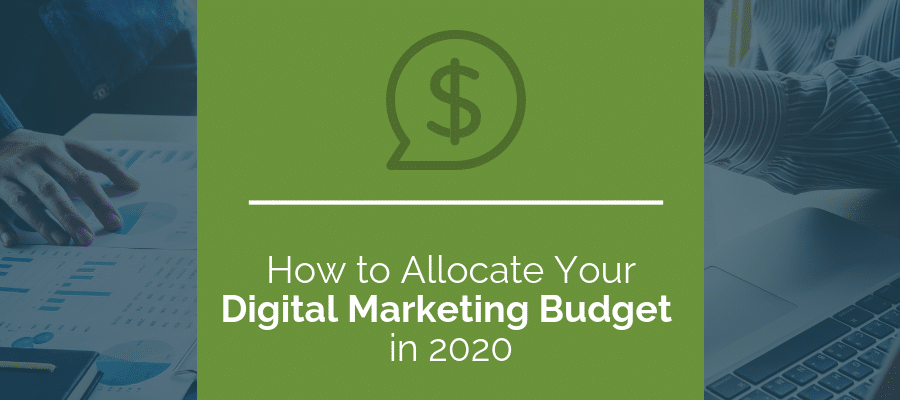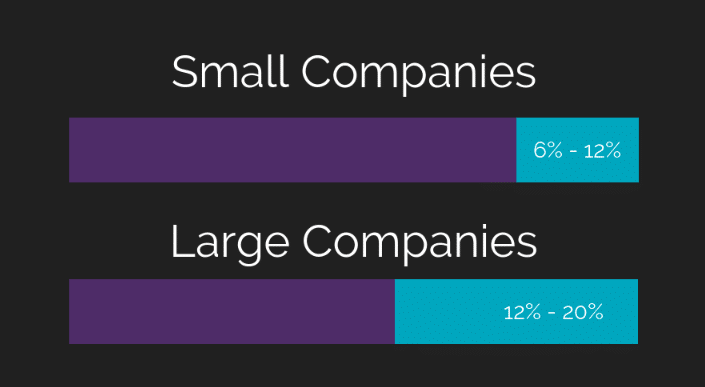
An accurate, effective digital marketing budget is a critical asset, and is only becoming more important as time goes on. But what makes your budget accurate and effective? If you’re stumped on how to best allocate your digital marketing budget in 2020, we’ve updated our previous post to provide some insight for the future.
Here’s how to allocate your digital marketing budget in 2020
What should your marketing budget be?
10% of revenue is often the baseline number used for planning marketing budgets. However, digital marketing isn’t one-size-fits-all. How you allocate your digital marketing budget in 2020 will depend on your industry, company size, company history, existing digital presence, and your goals. For example, a look at big company’s marketing budgets shows that Salesforce allocates a shocking 46% of their revenue to marketing (that’s over $4.8 billion!). On the flipside, Apple invests only 6% (though this is still about $16 billion).
Overall, the consumer packaged goods industry spends the most on marketing, about 24% of revenue, while energy companies spend the least, only 4%. When it comes to company size, it’s probably no surprise that the biggest companies (those with more than $10 billion in revenue) tend to spend more than average, however not by much—11.6%. Companies making between $500 million and $1 billion are under the mark at 8.5%. For companies making less than $5 million, this can be anywhere from 6% to 12%.
So what about your digital marketing budget in 2020? Each company is different, but it’s generally true across the board that more marketing investment drives more growth. However, how much you spend is less important than what you spend it on. Let’s take a closer look.
Simplify your marketing budget.
Download the free Marketing Budget Template.
Pull data and set goals
Before you divvy up your digital marketing budget in 2020, you’ll need to examine your data and set goals. Pull benchmark data on your current performance so you have something to compare to when analyzing the success of your digital marketing efforts. Also, take into account your past marketing efforts. Determine what channels have worked and what haven’t so that you don’t make the same mistakes twice. Make a plan to get the most out of your marketing budget.
Finally, you’ll need to take into consideration where your competitors stand. Each industry is different, so using your competitors for guidance about where you should spend your money and how much you should spend will help you compete in your industry. Start with a competitive analysis to see where your competitor’s strengths and weaknesses are, and how that fits with their marketing budget.
How to allocate your marketing budget
Here’s an example of how you might allocate your marketing budget in 2020, with some new trends to look for to get ahead of your competitors.
#1: New Marketing Software
Your marketing tech stack is one of the most important parts of your marketing budget in 2020. Garter reports that, for most marketers, marketing technology is the number one expense. Marketing technology comes in at about a 30% of the marketing budget, and this number is increasing year over year. This makes sense, since your marketing software can save your hours everyday, make your marketing process much more efficient, and allows you to target your audience more effectively.
To allocate your tech stack and marketing budget in 2020, consider the benefits of automation, and which parts of your process could most benefit from software upgrades. Also, consider which parts of your digital strategy aren’t performing, and where you might use free software instead. Here are a few examples of digital marketing technology you might use. Most of these have paid and free versions, with different levels of functionality. Many of these overlap, while some perform specific functions.
- CRM: Hubspot, Salesforce, Zoho, Freshsales, Keap
- Marketing automation: Hubspot, Keap, ActiveCampaign, Marketo, Pardot
- Email automation: Hubspot, Mailchimp, ConvertKit, Keap, Constant Contact,
- Social media scheduling: HootSuite, Buffer, BuzzSumo, Crowdfire
- Marketing reports: Google Analytics, Cyfe, Megalytic, Databox, Klipfolio
- SEO: SEMrush, Raven, BuzzSumo, Google Keyword Planner, Ahrefs, Moz
#2: Branding
To set your business apart from the pack, branding has become even more important in 2020. It’s essential to have a good understanding of what your target market is like; who are they? What do they care about? Where do they spend their time? Answers to these questions will help you reach your target market most effectively, and avoid wasting money on marketing strategies with low conversion. The following strategies can help you build or reinforce your brand in 2020:
- Search ads: If your target market is already searching for your services, not appearing ultimately means lost sales dollars. Targeted PPC ads will ensure that your brand shows up with the right message for the right people at the right time.
- Remarketing ads: remarketing ads are essential to brand reinforcement. Running remarketing ads makes your brand reappear to people who have already seen it, which helps to drive the message home.
- Social Media ads: As of 2020, social media ad spending is set to reach $38 billion in the U.S. alone. This means social media ad spending has more than doubled in four short years ($15.6 in 2016). If you haven’t used social for brand reinforcement yet, 2020 is the year.
#3: Content marketing
Another area to allocate your marketing budget in 2020 is towards content marketing efforts. Digital marketing is still based around information exchange, and this means impactful content is still a powerful tool. In 2020, it’s time to fine-tune your content marketing strategy and align it with your sales funnel. You won’t need any expensive tools and there are no short-cuts to this, but you will need talented marketing strategies, writers, and designers.
#4: SEO
Ultimately, a good digital marketing strategy means that your company is easy to find. This starts with search engine optimization (SEO). In 2020, this is more competitive than ever, but don’t be discouraged. You don’t need to show up at the top of every search, or even the most popular. Get inside your customers’ heads and concentrate on organic SEO strategy that makes sense for them. Focus on keywords that convert, and align it with your content strategy. This doesn’t have to be the most expensive part of your digital marketing strategy in 2020 to be effective.
#5: Social Media Marketing
As of 2020, 90% of brands reported using social media as a marketing tool. Social media platforms now cater to all age groups, professions, and lifestyles, with potentially lucrative niches in each. They key to knowing how to allocate your digital marketing budget in 2020 when it comes to social media is to have a social strategy in place beforehand. What do you want to accomplish with social media? How will you do it? How much time and what resources will you need? What platform does your target market use and how do they use it?
Facebook still represents the majority of ad spending (about 80%), and their highly-targeted ad options reveal why. This might be the ideal platform for you, but other platforms also present opportunities, especially for those in competitive industries. Consider rising stars like Instagram, especially for consumer products, local businesses, and loyalty-intensive brands, or blogging platforms like Reddit or Tumblr and the highly-specific communities therein.
#6: Email Marketing
Though it’s certainly not the newest trick in the book, email marketing is still an important part of your digital marketing budget in 2020. Targeted email workflows are a key component to moving leads through your sales pipeline. However, it’s no longer effective to send one-off emails without an accurate follow up or consistency. Consider your email strategy as a way to stay in touch with interested potential customers, current customers, or loyal brand evangelists. Use your email marketing strategy to convey important, useful, impactful information, not to simply fill inboxes.
#7 Video
Video is the fastest-growing type of media online. Relevant videos get priority spots on search engine results pages, and videos get more impressions, engagement, and shares than any other type. Even if it’s a small part, adding video to your digital marketing budget in 2020 will help you get ahead in a space that will become more important with each coming year. Brands that secure a position in video—whether through YouTube, social media, vlogs, or something else—will find themselves in a powerful position as competitors start to move into this space.
Take a hard look at your data to figure out what your marketing budget looks like this year. Once you have a base budget in mind, use these 7 factors to determine where to allocate your digital marketing budget in 2020. Allocating your budget in the right way can make or break how effective your digital marketing efforts are at bringing in new leads and closing sales.
Simplify your marketing budget. Download the free Marketing Budget Template

